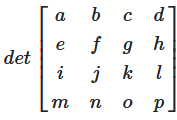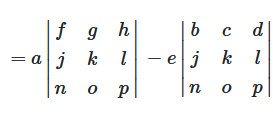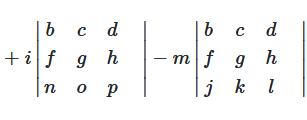Determinant of a matrix
Description of determinants of a matrix with examples
The determinant is a number (a scalar) that is assigned to a square matrix and can be calculated from its elements. It is a useful tool for solving linear systems of equations.
The determinant of a 2 x 2 matrix is calculated as
Note the alternative notation used to indicate a determinant; vertical bars instead of brackets as used for a matrix.
For a 3 x 3 matrix the determinant is found by expanding it in terms of three 2 x 2 determinants. One takes the elements of any row, multiply each by the determinant that remains if you delete the row and column to which the element belongs, and add these up while alternating the arithmetic sign
For a 4 x 4 matrix, the same procedure is used
The 2 x 2 sub determinants for the 3 x 3 main determinant, or four 3 x 3 determinants for the 4 x 4 main determinant, are known as minors. For example, the first of these is called the \(minor\, of\, a\). Note how the signs put in front of each term alternate between positive and negative, always starting with a positive sign for the \(a_{11}\) element.
Properties of Determinants
A 2 x 2 determinant is a sum of twofold products, and a 3 x 3 determinant a sum of threefold products.
Generally, when we have simplified all the minors in working out a large determinant, repeating as many times as necessary as the sub-determinants become smaller in each round, until all determinants have been eliminated, we are left with a sum of terms.
For an n-dimensional determinant, each term in the sum consists of a product of n elements of the matrix. Each of these comes from a different (row, column) combination.
A number of properties follow from fully expanding determinants.
-
Interchanging of two rows or columns makes a change of the sign of the determinant




-
Multiplying any row or column by a scalar constant is the same as multiplying the determinant by that constant.
-
If any two rows or columns are equal, the determinant is zero.
-
Adding a multiple of one row or column to another row or column does not change the determinant.
Matrices Calculation
Matrices Addition
Matrices Subtraction
Matrices Multiplication
Matrices Inverse Cramer method
Matrices Inverse Gauss-Jordan
Matrices and Simultaneous Equations
Matrices and Determinants
Row Operations of Matrices
Matrices and Geometry, Reflection
Matrices and Geometry, Plane Rotation
Singular Matrix
A matrix is singular, if the determinant is zero. From the above properties of determinants, we can follow: the value of the determinant is 0, if any of the following is true
-
All elements of one row or column are zero
-
Two rows or columns are identical
-
Two rows or column are proportional
Determinants of triangular matrix
For a triangular matrix the determinant is the product of the diagonal elements.
In the case of a triangular matrix all the terms of the determinant are equal to zero except \( aei\), because the elements \(d\), \(g\) and \(h\) are equal to zero. That's why the determinant is the product of \(aei\) is
Online calculator for Determinant
|
|








